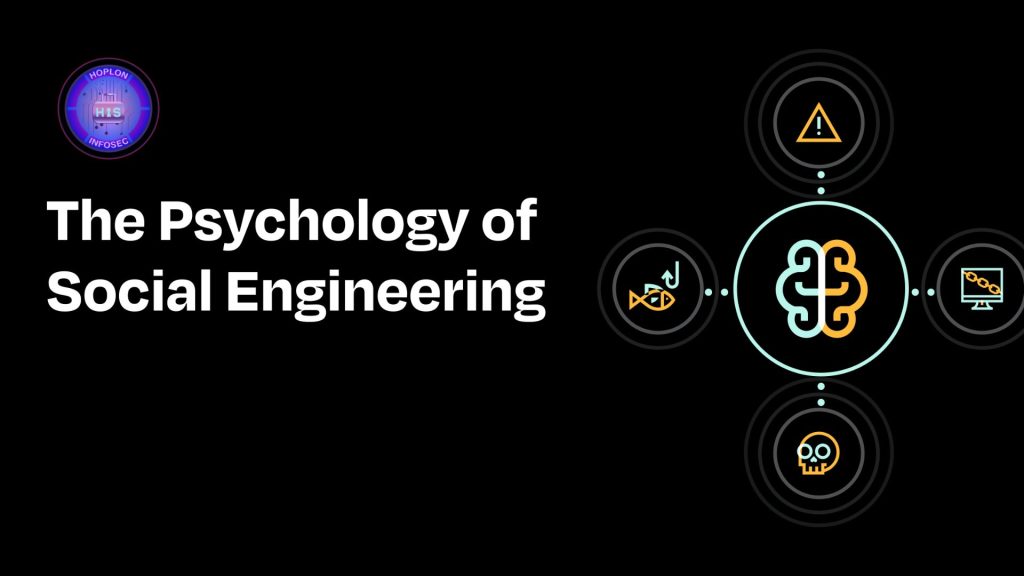The Psychology of Social Engineering: Defending Against Human-Based Threats

Hoplon InfoSec
22 Apr, 2025
Social engineering remains one of the most persistent and dangerous threats in cybersecurity—not because of system vulnerabilities or advanced malware, but because it exploits the most unpredictable element in any organization: human behaviour.
Unlike technical exploits that seek out weaknesses in software or hardware, social engineering attacks manipulate people into making security mistakes. The target isn’t a firewall or a server—it’s a person, often unaware that they’re being manipulated.
To combat these types of threats, it’s no longer enough for security teams to focus exclusively on technical controls. Understanding the psychological principles that make social engineering so effective is now essential. Without this understanding, even the most advanced cybersecurity infrastructures can be undone by a single successful deception. In this blog we will discuss about Psychology of Social Engineering.
Why Human Behavior is the Weakest Link
Humans are naturally inclined to trust. Our brains are wired to respond in specific, predictable ways to social cues, authority figures, emotional appeals, and time-sensitive situations. These psychological reflexes help us navigate daily life efficiently, but in the wrong hands, they can be turned against us.
Cognitive psychology has shown that people often rely on mental shortcuts—known as cognitive biases—when making decisions. While these shortcuts are useful for efficiency, they also open the door to manipulation. Social engineers study these patterns to craft compelling schemes that bypass logic and elicit emotional responses.
By leveraging the human tendency to trust, obey authority, reciprocate favours, or respond to urgent cues, attackers can trick users into giving up sensitive data, clicking malicious links, or even physically granting access to secure areas.
Organizations must understand the threat landscape’s technical and psychological dimensions to defend against social engineering effectively.
The Psychology of Social Engineering

Exploiting Hardwired Biases
Social engineering works because it taps into fundamental human psychology. Attackers use cognitive biases and emotional triggers to prompt impulsive, irrational actions. Here are some of the key psychological principles commonly exploited:
- Authority Bias: People tend to comply with requests from perceived authority figures. A message that appears to come from a CEO or government official often overrides usual scepticism.
- Reciprocity: If someone does us a favour, we feel compelled to return it. Attackers may exploit this by offering assistance or information to elicit cooperation.
- Scarcity: When an opportunity appears rare or time-sensitive, we’re more likely to act quickly without evaluating risk.
- Social Proof: People often look to the behaviour of others for guidance, especially in uncertain situations. If an email implies that “everyone” has complied, individuals are more likely to follow suit.
These principles are often invisible to the victim at the moment, which is why traditional training that focuses solely on “do this, don’t do that” is insufficient.
The Gap Between Technology and Psychology
Many organizations invest heavily in firewalls, antivirus programs, and intrusion detection systems. But these tools can’t prevent an employee from handing over their login credentials to someone pretending to be from IT support.
Social engineers operate in this gap between technical defences and psychological vulnerabilities. Until organizations recognize the depth of this gap, they remain exposed to human-centred threats.
Common Social Engineering Tactics and Their Psychological Triggers

To build a resilient defence, it’s critical to understand how attackers design their schemes and what psychological levers they pull to ensure success.
Phishing
Phishing is the most well-known form of social engineering. A deceptive email, often from a trusted source, pressures the victim to act immediately—click a link, download a file, or enter credentials. The sense of urgency combined with authority cues (like a CEO’s name or a bank’s logo) overwhelms rational thinking and induces compliance.
Pretexting
In pretexting attacks, the attacker creates a false scenario or identity to gain the target’s trust. These narratives tap into our natural love of storytelling and our tendency to accept plausible explanations without deep scrutiny. Pretexting often exploits empathy, credibility, and professional courtesy, making the victim more willing to share sensitive information.
Baiting
This tactic involves offering something enticing—like free music, exclusive files, or even physical USB drives—to lure victims into compromising their systems. Baiting preys on curiosity and the desire for reward, sometimes even ego or status (“You’ve been selected!”).
Quid Pro Quo
This attack relies on reciprocity. For example, an attacker might offer technical assistance in exchange for login details or ask for a small, harmless favour. Victims may feel a subconscious obligation to return the “favour,” not realizing they are being exploited.
Tailgating
Tailgating is a physical attack vector where the attacker gains unauthorized access to a secure area by following someone with legitimate access. This tactic exploits social compliance, courtesy, and the desire to avoid confrontation.
The Overlooked Role of Psychology in Security Incidents
When a social engineering incident occurs, organizations often ask: “What technical control failed?” However, a more helpful question might be: “What psychological trigger led to human error?”
Failing to consider the psychological catalysts behind the breach leads to a cycle of applying the wrong solutions to the wrong problems. Technical tools alone cannot solve a problem that originates in human cognition. This blind spot keeps organizations vulnerable despite significant cybersecurity investments.
To address this, security strategies must incorporate behavioural science and psychology into their frameworks.
Building Psychological Resilience in Organizations
Moving Beyond Rules-Based Training
Traditional security awareness training often focuses on checklists, rules, and procedures. While these are important, they don’t prepare individuals for the emotional and cognitive manipulation that social engineering employs.
For real change to happen, organizations must shift their focus from enforcing compliance to building resilience. This means training individuals to recognize, regulate, and respond to psychological manipulation.
Scenario-Based Simulations
One of the most effective methods for increasing psychological resilience is scenario-based training. These simulations mimic real-world attacks and create emotional pressure—urgency, fear, temptation—so employees can practice managing their responses in a safe environment.
Through repetition and emotional rehearsal, individuals become better equipped to pause, evaluate, and act thoughtfully when confronted with similar situations in real life.
Creating Psychological Safety
Another essential component of a resilient security culture is psychological safety. Employees must feel comfortable reporting suspicious activities, even if they fear they’ve made a mistake.
Blaming or punishing employees for falling victim to sophisticated manipulation only reinforces silence and denial. Instead, organizations should normalize the idea that anyone can be targeted and that reporting is a sign of strength, not weakness.
Leadership by Example
Leaders play a critical role in shaping culture. When security leaders share their own experiences with phishing or manipulation attempts, it sends a powerful message: vulnerability is human, and vigilance is shared.
This transparency fosters trust and encourages team members to speak up without fear of judgment or reprisal. Over time, this creates an environment where security is seen not as a specialized responsibility but as a collective one.
Integrating Psychological Insight into Cybersecurity Strategy

The most effective cybersecurity strategies are those that integrate technical solutions with a deep understanding of human psychology.
Cybersecurity is no longer just about systems and software—it’s about people. Protecting people requires us to understand how they think, feel, and behave under pressure. It requires empathy, education, and consistent reinforcement.
By adopting a dual-lens approach—technical and psychological—organizations can close the gap that social engineers exploit and build a security culture that is not only compliant but truly resilient.
Final Thoughts
The landscape of cyber threats continues to evolve, and attackers are becoming increasingly sophisticated—not only in their tools but also in their understanding of human behaviour.
Security leaders who ignore the psychological dimension of social engineering leave their organizations exposed. However, those who embrace this understanding and adapt their training, culture, and leadership style can create an environment that is prepared, aware, and empowered.
Building psychological resilience is not a one-time fix—it’s a continuous process of education, empathy, and engagement. In doing so, organizations can transform their people from the weakest link into the first line of defence.
Share this :